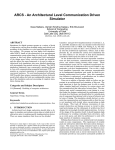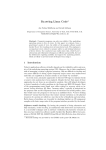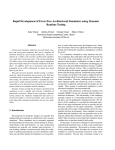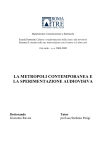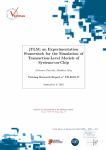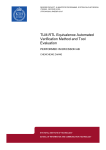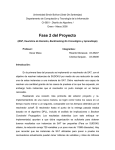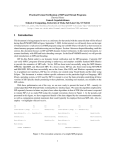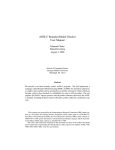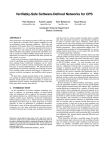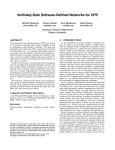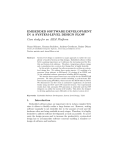Download view Pdf - Informatik - FB3
Transcript
Simulation-based Equivalence Checking between
∗
SystemC Models at Different Levels of Abstraction
Daniel Große1
1
Markus Groß1
Ulrich Kühne2
Rolf Drechsler1
Institute of Computer Science, University of Bremen, 28359 Bremen, Germany
{grosse,mgross,drechsle}@informatik.uni-bremen.de
2
LSV ENS de Cachan, 94235 Cachan, France
[email protected]
ABSTRACT
1. INTRODUCTION
Today for System-on-Chips (SoCs) companies Electronic System Level (ESL) design is the established approach. Abstraction and standardized communication interfaces based
on SystemC Transaction Level Modeling (TLM) have become the core component for ESL design. The abstract
models in ESL flows are stepwise refined down to hardware.
In this context verification is the major bottleneck: After
each refinement step the resulting model is simulated again
with the same testbench. The simulation results have to
be compared to the previous results to check the functional
equivalence of both models. For models at lower levels of
abstraction strong approaches exist to formally prove equivalence. However, this is not possible here due to the TLM
abstraction. Hence, in practice equivalence checking in ESL
flows is based on simulation. Since implementing the necessary verification environment requires a huge effort, we
propose an equivalence checking framework in this paper.
Our framework allows to easily compare variable accesses in
different SystemC models. Therefore, the two models are
co-simulated using a client-server architecture. In combination with multi-threading our approach is very efficient as
shown by the experiments. In addition, the time required
for debugging is reduced by the framework since the respective source code references where the variable accesses did
not match are presented to the user.
For a long time Register Transfer Level (RTL) has been
sufficient for modeling. But around 2000 System-on-Chips
(SoCs) reached a complexity which made higher abstraction mandatory. This strategy was implemented and Electronic System Level (ESL) design emerged [2]. A widely accepted language for ESL design is SystemC [20, 14, 15, 13].
As a C++ class library SystemC perfectly supports abstract modeling, in particular Transaction Level Modeling
(TLM) [6, 11].
In an ESL design flow starting from the textual specification, the algorithmic design is specified first. At this
level the basic functionality of the system is explored and
defined no matter which parts become hardware or software. Afterwards the system is refined to a TLM model.
This model consists of modules communicating over channels, i.e. data is transferred in terms of transactions. Within
TLM different levels of timing accuracy are available such
as untimed, loosely-timed, approximately-timed and cycleaccurate. The respective levels allow e.g. for early software
development, performance evaluation and HW/SW partitioning. As the last step of the ESL flow the hardware part
of the TLM model is refined to RTL.
However, the dominating factor in ESL design is still verification. Following the refinement steps the same testbench
can be basically reused at lower levels applying the transactor concept of SystemC. By this, during simulation the same
high-level input is fed into both models but a huge effort is
required to implement the verification environment which
has to perform the actual equivalence check.
In the pure hardware domain where lower level models
are considered – e.g. RTL or gate-level models – Equivalence
Checking (EC) based on formal methods has been very successful [12, 8]. A distinction is made between combinational
EC and sequential EC. In combinational EC two designs
without memory elements are tested for equivalence. In contrast, sequential EC aims to verify whether two sequential
circuits have the same functionality. If the state encoding is
the same, the problem can be reduced to the combinational
case. Otherwise, the problem is much harder, but a lot of
progress has been made (for an overview see e.g. [19]). However, all these methods can only be applied if both models
can be compiled into a circuit-like representation which is
not the case for TLM descriptions.
Recently, there has been research targeting equivalence
checking between system-level models and RTL. Basically,
the idea of [23] is to identify sequential compare points,
i.e. variables which should have the same value with respect to the considered time domain. But this approach
requires explicit timing information which is not available
at TLM. The authors of [5] propose the notion of eventbased equivalence for SystemC TLM and RTL models. The
Categories and Subject Descriptors
J.6 [Computer-Aided Engineering]: [Computer-Aided
Design (CAD)]
General Terms
Verification
Keywords
Transaction Level Modeling, Equivalence Checking, Debugging, SystemC
∗This work was supported in part by the German Federal
Ministry of Education and Research (BMBF) within the
project SANITAS under contract no. 01M3088.
Permission to make digital or hard copies of all or part of this work for
personal or classroom use is granted without fee provided that copies are
not made or distributed for profit or commercial advantage and that copies
bear this notice and the full citation on the first page. To copy otherwise, to
republish, to post on servers or to redistribute to lists, requires prior specific
permission and/or a fee.
GLSVLSI’11, May 2–4, 2011, Lausanne, Switzerland.
Copyright 2011 ACM 978-1-4503-0667-6/11/05 ...$10.00.
theory of [5] has not been implemented for this scenario (the
experiments presented consider the setting of abstracting an
RTL model to TLM) and needs manual interaction to relate
the events at different abstraction levels. Other works such
as e.g. [18, 7] relate C programs to hardware description
languages. But these approaches all assume strict timing
information to be available. The authors of [10] present first
steps for equivalence checking using formal methods in combination with SystemC but do not consider TLM models.
The specific problem of handling memories in formal equivalence checking of system-level models against RTL has also
been considered [17].
In this paper we present a framework for equivalence checking between SystemC models described at different abstraction levels. In particular, we support TLM designs as typically used in ESL flows. The framework gives a pragmatic and easy-to-use solution for comparing model behaviors. Hence, a lot of time is saved which usually has to be
spent for implementing the respective verification environment. Based on minor extensions of the models the developed client-server architecture allows to simulate and compare the results very efficiently. The verification engineer
chooses which variables are used for comparison, e.g. internal variables, variables of the interfaces, members of transactions or even arbitrary C++ objects. In addition, the
verification engineer specifies whether a different ordering of
accesses to a variable is valid. For instance, a CPU refined to
a lower abstraction level may implement out of order execution and hence some data values can be different at certain
time points. In general, a trade-off between performance
and accuracy is possible based on the number of variables
included in the comparison.
Then for equivalence checking, both SystemC models (the
clients) are co-simulated (controlled by the server) and
thereby the comparisons are carried out.
Different methods for co-simulation using SystemC have
been proposed in the literature, see e.g. [3, 9, 22]. However,
all these papers consider SystemC-based environments for
co-simulation of hardware and software, i.e. connecting different worlds. To the best of our knowledge no framework
has been proposed supporting the design and verification
teams in equivalence checking when refining the system to
lower levels of abstraction. We close this gap here and improve the productivity of SystemC-based ESL design flows.
Overall, we summarize the contributions of this paper as
follows:
• Equivalence checking framework
A framework for equivalence checking of SystemC models in form of a library is introduced. The framework
provides easy-to-use interfaces to compare the behavior of different SystemC models by only minor extensions of the models.
• Efficiency
The client-server architecture of our framework makes
intensive use of multi-threading. Thereby, the approach
benefits from multi-core systems and as a result very
fast variable comparisons can be performed.
• Debugging
The generated equivalence report summarizes important information for the user. In particular, in case of
non-equivalent behavior of the checked SystemC models the developed approach helps to detect and locate
the bug quickly due to reported variable access information.
We present experimental results demonstrating the advantages of our framework. For a CISC CPU developed in a
top-down ESL design flow two major bugs have been found
using this framework.
Client
Client
SystemC model 1
SystemC model 2
Server
Equivalence Checker
Equivalence
report
Figure 1: Overall Flow
2. EQUIVALENCE CHECKING OF
SYSTEMC MODELS
In this section the equivalence checking approach to compare the behavior of different SystemC models is introduced.
For this task we have developed a framework which has been
built as a client-server architecture. The equivalence checking server interacts with exactly two SystemC models, which
in turn act as clients. Three phases need to be followed using
the proposed approach: model extension, equivalence checking, and report analysis. Before we explain these phases in
detail, the overall flow is presented.
2.1 Overall Flow
Figure 1 depicts the overall flow of the proposed approach.
At the starting point there are two SystemC models which
are to be compared. They have to be extended in order
to function as clients for the equivalence checking server.
This extension process consists of two steps. First, a model
has to be analyzed to determine which variables1 should be
used for comparison during equivalence checking. Second,
the verification engineer extends the model by using our library. In doing so, the SystemC model is augmented with
networking functionality and can connect and communicate
as client with the EC server. The extended model is then
compiled into an executable. This process needs to be performed for all SystemC models whose equivalence is to be
checked. Since only minor extensions of the SystemC models have to be carried out this is a very convenient process.
Furthermore, this procedure fits perfectly into the refinement steps of typical ESL design flows.
To perform the equivalence check our server first has to
be executed. Then, both models have to be started to begin
their simulation. During the equivalence check both clients
send their data to the server. The server collects the data
and continuously checks if the two models show the same
behavior. Finally, at the end of the equivalence check a
report is generated. This report summarizes the results of
the comparison for each variable over the simulation time,
e.g. if there have been mismatches during read or write of a
concrete variable as well as the frequency of such events.
In the following the three phases are described in more
detail.
2.2 Model Extension
2.2.1 Analysis
Each model contains a set of variables important to the
model’s behavior. The verification engineer determines which
1
We use the general term of variables here to cover arbitrary
C++ objects which of course also include specific SystemC
types. Concrete examples are presented in the following
sections.
variables should be compared in the equivalence checking
phase. A huge list of variables covered by the check is likely
to decrease the performance. The more variables are chosen, the more data has to be sent to the server and stored in
memory (for some time). Therefore, a minimal but sufficient
set of variables should be selected.
In addition, the verification engineer needs to decide whether
a read and/or write action on a variable is crucial to the
model’s behavior. If the value read from a variable is not
needed, it should not be sent to the server. This way the
data transferred through the communication sockets is minimized.
2.2.2 Extension
The next step is the extension of the SystemC model. The
global variable ec is declared at first. This variable contains
an instance of the developed class EquivCheck. This class
is part of our equivalence checking framework and comes
with our library libec. The class EquivCheck provides the
functionality to communicate with the equivalence checking
server as well as functions to help recording the required
data. Moreover, it offers methods to register a set of variables to include them in the equivalence check.
The verification engineer selects a list of variables that
shall be used to determine whether the two models behave
in the same way. The next step is to spot all locations in the
model’s source-code where one of these variables is accessed
in a reading and/or writing way. Once these locations have
been determined, every access needs to be reported to the
server. The data sent to the server contains the following
information:
1. the id of the variable (specified at registration),
2. the access type (read or write),
3. the address where the variable is accessed (particularly
important for arrays),
4. the current value in case of a read access, the new value
in case of a write access.
In the following we give a concrete example demonstrating
the model extension.
Example 1. Consider a CPU and a memory while the
memory is a separate module in a SystemC TLM model. Assume, the CPU wants to read the value of a specific memory
address. The CPU communicates with the memory using
the blocking transport interface of TLM-2.0 [21]. So in the
TLM memory the method b_transport as shown in Figure 2 is implemented. The memory itself is modeled as an
integer-array inside the memory module. In line 10 the value
of the memory address (given by addr, which has been extracted from the payload; see line 4) is read from the array
and thereafter copied to the transaction. In this example the
verification engineer decided to compare also read accesses
with the second SystemC model and hence wants to report
these to the equivalence checking server. This is done from
line 13 – line 14. The function report is available via our
EquivCheck class. It takes the id of the variable ( ID_MEM),
the type of access ( ACCESS_READ), the value of the memory
address as string and the address of the access as parameters. As a result of calling this function the data is processed
and sent to the server.
Figure 3 depicts the same function implemented in the
RTL model of the memory. Again, the value read from the
memory is sent to the server (see line 12 – line 13).
1
2
3
4
5
6
7
8
9
10
11
12
13
14
15
16
17
18
19
20
void Memory::b transport(tlm::tlm generic payload& trans,
sc time& delay) {
tlm::tlm command cmd = trans.get command();
sc dt::uint64 addr = trans.get address();
size t length = trans.get data length();
uint32 t∗ data = reinterpret cast<uint32 t∗>
(trans.get data ptr());
if (cmd == tlm::TLM READ COMMAND) {
memcpy(data, &mem[addr], length);
// report value read from memory
ec.report(ID MEM, ACCESS READ,
toString(∗data), addr);
} else if (cmd == tlm::TLM WRITE COMMAND)
[...]
trans.set response status(tlm::TLM OK RESPONSE);
}
Figure 2: TLM model: read memory value
1
2
3
4
5
6
7
8
9
10
11
12
13
14
15
16
void Memory::entry() {
if (req.read()){
ack = true;
if (rw.read()) // write access
[...]
else { // read access
int addr = addr i.read();
data o = (mem[addr], mem[addr + 1],
mem[addr + 2], mem[addr + 3]);
// report value read from memory
ec.report(ID MEM, ACCESS READ,
toString(data o.read()), addr);
}
}
}
Figure 3: RTL model: read memory value
As can be seen in the example based on our library only a
single function call to use the respective data for equivalence
checking has to be inserted into a SystemC model.
In the following the equivalence checking phase of the proposed approach is described.
2.3 Equivalence Check
In the equivalence checking phase the server collects data
from the two clients and analyzes this data. On top of the
client-server architecture the server functionality has been
separated into multiple threads. For each connected client
one thread collects the incoming data. Furthermore, for each
registered variable a thread is created to compare the respective data. This extensive use of threads greatly improves the
overall performance on multi-core systems as shown later in
the experiments. Before we describe the equivalence checking process, we define under which conditions two models
are considered to show the same behavior.
Given two SystemC models, M1 and M2 , let the variable
set of M1 be V1 and of M2 be V2 . Moreover, based on the
model extension phase let the set of selected variables be
S1 ⊆ V1 and S2 ⊆ V2 , respectively.
As we consider the model behavior of both models with
respect to simulation there is a certain timestamp t describing the current progress of the overall simulation. Now, the
set S1t (S2t ) describes the values of all selected variables of
model M1 (M2 ) at time t.
Since all models send their data in a normalized form to
the EC server, each model requires a transformation function to accomplish this normalization. More precisely, the
function fi normalizes the values of a set of selected variables
to allow the equivalence checking server to compare them.
For example, if in a high level model configuration variables
have been declared separately, and in the corresponding RTL
implementation they have been embedded into different configuration registers, the transformation function extracts the
separated values and combines them to a single one2 . Now,
we can define the equivalence criterion:
Definition 1. Two models M1 and M2 are equivalent
with respect to the selected variable sets S1 and S2 at time
t, iff
f1 (S1t ) = f2 (S2t ).
For this definition we have to specify when two normalized
values of a variable match: Due to the event-based scheduler of SystemC it may happen that a SystemC process is
executed more than once in the current simulation cycle.
In this case the process may report intermediate values to
the EC server, which are irrelevant. But this can be easily recognized by keeping the last sent value in the server,
i.e. all values up to this last sent value have been computed
in previous delta cycles and will be discarded3 . Finally, the
following definition results:
Definition 2. During equivalence checking of two SystemC models two variables at a certain simulation cycle match,
iff both latest (stabilized) values with respect to the delta cycle concept are equal.
Using these definitions the equivalence checking works as
follows: After compilation of the extended models the server
has to be executed. Then, both models have to be started.
In the beginning of their simulation each model connects
to the server. As a second step they register all variables
they want to compare during the equivalence check at the
server. Based on the registration id variables are matched.
Variables only present in one of the two models are discarded
with a warning. This process takes place before any of the
considered variables are read or written.
Next, the simulation of the models continues. While their
simulation advances, registered variables in the SystemC
models are read and written. Since the models have been
extended, these accesses are sent to the server and are stored
in the corresponding data structures. The main data structures used in the server are based on Standard Template
Library (STL) deques [1]. This type offers performance
enhancements compared to lists or vectors because deques
grow much more efficiently and avoid reallocation of its elements. Also the equivalence checking server has to handle
large amounts of data and the deques have to grow and
shrink very frequently. While both models are running and
sending data to the server, the server itself collects the data
and tries to match them according to the definitions from
above. Typically, we use a fixed block size (standard value
is 100,000) for storing incoming accesses. If this number is
exceeded in both models, a process matching the variables
is invoked. To reduce the memory usage of the equivalence
check every successful compared pair of values is removed
immediately, but added in the statistics. We explain the
respective details in the next section.
2.4 Report Analysis
Finally, after both models have finished their simulation,
the server generates a report. This report contains important statistical information for the verification engineer. It
2
Often the transformation function is nothing else than the
identity.
3
We use sc_time_stamp to identify the current simulation
cycle, thereby revealing the timestamp advance.
lists all variables divided into read access and write access.
In addition, several counters are associated to each variable,
displaying the number of total accesses, matched accesses,
unmatched accesses and swapped accesses. Total accesses
equal the number of all accesses, and matched accesses follow Definition 2. An unmatched access is an access that
appeared in only one model and could not be matched to an
access in the other model. These accesses suggest a difference between the behavior of both models and need further
investigation on behalf of the verification engineer. Swapped
accesses may occur when a model performs the same accesses
to a variable but in a different order. This may happen for
instance in a CPU implementing out-of-order execution. In
this case the instructions that are executed may be dynamically reordered by the CPU and therefore cause a slightly
different order of the variable accesses. The user specifies a
maximal window size w which is used to match the second
value by considering all values up to w steps in the future of
the other SystemC model. Extending Definition 1, this behavior is formally described using an out-of-order function o
which permutes a set of variable sets starting from a specific
time t up to time t + w. This yields the following definition
of equivalence:
Definition 3. Two models M1 and M2 are equivalent
with respect to the selected variable sets S1 and S2 and the
out-of-order function o at time t, iff
f1 (S1t ) = f2 (o(S2t , S2t+1 , . . . , S2t+w )).
Finally, due to the reported statistical information the
verification engineer is able to determine which variable has
been read and/or written differently and the frequency of
such an event. It is also shown if only read or write accesses
are unmatched or both. This statistical information has to
be analyzed by the verification engineer.
In the following we present an example of an equivalence
report.
Example 2. Consider again the CPU and the memory
presented in Example 1. We have shown already how reading a value from a specific memory address has been implemented (and sent) in a TLM model (see Figure 2) and in
the corresponding RTL model (see Figure 3), respectively.
Assume, both models are checked for equivalence. It is examined whether the same read accesses to the memory give
equivalent results (see also model extension phase in the last
section). The resulting report is shown in Table 1. As can
be seen, there are many unmatched read memory accesses.
This means that both models behave differently. To track
down the error the code for reading from a memory address
has to be analyzed in both models (from there the variable
accesses have been reported). From Table 1 we see that there
are matched cases as well. Hence, we compared only a few
simulation scenarios for both results, i.e. where (a) the values for data_o matched and (b) the values for data_o that
did not match. In conclusion, the bug was implemented in
the RTL model while refining the TLM model (see line 8 –
line 9 in Figure 3): Four 8-bit values are assigned to the
variable data_o, but they have been arranged in the opposite
order. Figure 4 gives the correct assignment to data_o. Using our equivalence checking approach we were able to show
that both models have the same behavior after the fix.
In the next section the proposed approach is studied for
a CISC CPU.
3. EXPERIMENTAL EVALUATION
In this section the proposed approach is exemplified for
a CISC CPU used for educational purposes. First, the basics of the CPU are briefly described. Following a top-down
Table 1: TLM and RTL equivalence report
MEMORY
1
2
3
4
5
6
Equivalence check of TLM and RTL
Reading variable accesses
ID
Total
Matched
Swaps
0
1,452,524
85,532
0
Unmatched
1,366,992
[...]
else { // read access
int addr = addr i.read();
data o = (mem[addr + 3], mem[addr + 2],
mem[addr + 1], mem[addr]);
[...]
Figure 4: RTL model: read memory value (corrected)
ESL design flow, the hardware implementation of the CPU
has been developed. During the respective refinement steps
we applied the proposed equivalence checking approach to
verify the consistency of the SystemC models. The different phases to apply our approach are demonstrated and the
results are discussed. Finally, we also evaluate the performance gains resulting from the client-server architecture using multi-threading.
3.1 CISC CPU
We consider a modified version of the Y86 CPU [4]. The
Y86 CPU is a simple CISC CPU implementing a subset of
the instructions of the IA-32 architecture [16]. It has been
designed as von Neumann architecture. The data width of
the memory is 8 bit. In the modified version the memory size
is 8 KByte. The CPU has 8 registers with 32 bit data width
each. In total, the Y86 has 8 instructions: 2 arithmetic
instructions, 3 load/store instructions, 2 jump instructions
and 1 other instruction.
For the Y86 an Instruction Set Architecture (ISA) model is
available [4], consisting of 289 lines of code in a slightly modified version. This model, which is written purely in C++,
served as our high-level starting point for the ESL design
flow. We refined this model to a SystemC TLM model (465
lines of code) using TLM features like e.g. socket communication to connect the memory and the registers to the CPU.
Next, the TLM model has been refined again to SystemC
RTL (661 lines of code). The final RTL model implements
a 5 stage pipeline, which is not part of the ISA model.
In the following the process of extending a model is described for the Y86 CPU at hand.
3.2 Y86 Model Extension
The different models of the Y86 CPU have several variables in common. To perform the equivalence check a set of
variables had to be determined, which is used during the process to check the correspondence of both models. All models have the register and the memory variables in common,
i.e. during refinement additional details have been added
(e.g. pipeline stages etc.). But from the functional perspective the basic CPU registers as well as the memory remained
unchanged. Moreover, they describe the state of the CPU at
a fixed point in time independent of the level of abstraction.
Therefore, we selected these two variable arrays as variable
sets Si for the equivalence check. To complete the extension
process we augmented the models using the libec. Hence,
the models report the mentioned variable accesses.
3.3 Y86 Equivalence Checking
For the initial ISA model several programs for validation
have been developed. They have been successfully executed
on the ISA model. After each refinement step we also ex-
1
2
[...] = MEM[ea] | (MEM[ea+1] >> 8) |
(MEM[ea+2] >> 16) | (MEM[ea+3] >> 24);
Figure 5: ISA model: read memory value
ecuted the programs on lower level models, i.e. TLM and
RTL, respectively. However, without the proposed framework a direct and precise comparison requires a significant
effort for implementing the necessary validation environment. In contrast, with the framework we can easily and
efficiently check whether the models show the same behavior.
3.3.1 ISA and TLM model
First, we checked the equivalence of the Y86 ISA model
and the Y86 TLM model. As it turned out, they gave
the same results for most of the input programs, but failed
e.g. for a program implementing the bubble-sort algorithm.
The equivalence report revealed similar numbers as shown
in Table 1, i.e. most of the memory accesses did not match.
The input programs with just a few memory accesses did
not produce any unmatched memory accesses.
To find the source of the problem we compared the actual values of a read and write access to the memory. The
first few accesses were correct, but later almost no access
matched. As the values read or written to the memory are
32 bit wide, but the memory has an 8 bit data width, the
values are divided into four 8 bit parts. A value pair resulting from an unmatched memory read looks for example like
this (least significant byte is left):
ISA: f3-00-00-00 TLM: f3-d4-aa-b5
Each time the first 8 bit of both values were equal and the
remaining 24 bits were zero in the ISA model. The correct
value is the one of the TLM model because it was initially
written into the memory as test-data for the bubble-sort algorithm. This points towards an error in the ISA model.
After comparing the memory access functions in both models the error was found in the read memory function in the
ISA model. The relevant part of the function is depicted in
Figure 5. The variable ea denotes an offset for the memory
access and is irrelevant here. The ISA model divides an 32
bit value into four 8 bit blocks using right shifts when writing to the memory. These four values have to be shifted back
when being read from the memory. But instead of shifting
to the left, the ISA model again shifted to the right. This
way 3 of the 4 bytes became zero. The byte which did not
need to be shifted is read correctly from the memory.
This bug caused that all the programs which read only
small values (not larger than FF) passed the equivalence
check successfully. To correct this bug we simply had to
change the right shifts into left shifts. Overall, with the proposed equivalence checking approach we were able to detect
as well as locate the source of the bug quickly. Moreover,
after fixing the bug in the described way both models were
equivalent. Please note that the TLM model did not suffer
from this bug because it uses memcpy to read a 32 bit value
from the memory (analogously to line 10 in Figure 2).
3.3.2 TLM and RTL model
The RTL model of the Y86 CPU also behaved differently from the TLM model. Simple sequential programs
worked fine. However, when more complex programs using
the jump instruction have been executed the equivalence
check failed. More precisely, the RTL model never stopped
running and seemed being stuck in a loop. The equivalence
TLM: IP WRITE 1b y86_tlm/y86.cpp:237
RTL: IP WRITE 19 y86_rtl/y86_cpu.cc:246
The TLM model wrote the value 1b to the IP variable, while
the RTL model wrote 19. The file and location indicate
where the variable access was reported. After examining
the function to process a jump in both models (the returned
line number is within the respective code of the function) the
error was located in the computation of the target address in
the RTL model: When the RTL model computed the target
address after a jump, it did not add the length of the jump
instruction (2 bytes) to the address, whereas the TLM model
(and the ISA model) added the length. This target address
is stored in the IP. The above example clearly shows that
the RTL model did not increase the IP by 2 (the length of
the jump instruction). After fixing this bug the equivalence
report showed no unmatched variable accesses and the RTL
model terminated correctly for all test programs.
In summary, using the proposed equivalence checking framework also the bug and its location was found very fast. In
particular the verbose mode supported the localization.
In the following the efficiency of the approach is considered.
3.4 Performance Analysis
The equivalence checking server uses multiple threads and
can handle millions of variable accesses. In Figure 6 the runtime of a complete equivalence check between the Y86 TLM
and RTL model is shown. We performed the experiments on
a Core 2 Duo 2.8 GHz computer with 4 GB of main memory.
The more variables are chosen to be compared in the equivalence check, the longer is the run-time. Since the check
compares two models and hence we implemented separate
threads to handle the incoming data, the speed-up using a
dual-core CPU is within a factor of two in comparison to a
single core CPU. When using a CPU with more than two
cores a further speed-up can be expected because a separate
thread per variable is invoked.
4.
CONCLUSIONS
In this paper we have presented an equivalence checking
framework for ESL design flows. The framework has been
implemented as a library following a client-server architecture. The clients are the SystemC models checked for equivalence. They communicate with the server via sockets. For
equivalence checking read and write accesses of user selected
variables are reported to the server using the developed library. If all reported accesses can be matched, the SystemC
models have the same behavior.
In summary, our approach improves the design productivity since less effort is needed for setting up and performing
equivalence checking. We have also shown that the multithreaded architecture results in scalable equivalence verification. Moreover, in case of non-equivalent behavior the
4
This register points to the address of the next instruction.
Please note that the length of an instruction is between 1 to
3 bytes.
5
The jump-instruction jnz dist adds the given offset –
termed distance – to the IP if the zero flag has not been
set.
800
Single-Core
Run-time (seconds)
report revealed a lot of unmatched accesses to the Instruction Pointer (IP)4 . Using the verbose output mode of the
equivalence checking server we identified the first unmatched
IP access in the RTL and TLM model just during the processing of a jump-instruction5 . This was possible because in
verbose output mode the file and line of the location of the
unmatched variable access is displayed. The output was:
Dual-Core
600
400
200
0
012 4
8
16
Variables
32
Figure 6: Equivalence check run-time
time required for debugging is reduced because bugs can be
detected and located quickly with the verbose mode.
Several directions are left for future work. We plan to develop methods supporting the process of selecting variables
which have to be compared during the equivalence check.
Moreover, we want to investigate how our methods can be
combined with coverage techniques including functional as
well as code coverage techniques. As an example, the testcases need to be improved if based on the performed model
extension a certain (read or write) variable access is never
reported. Furthermore, we plan to integrate an interactive
debugging mode which uses a rollback mechanism for the
simulation such that more data in the context of an unmatched access can be analyzed.
References
[1] Standard template library programmer’s guide. http://www.sgi.com/tech/stl/.
[2] B. Bailey, G. Martin, and A. Piziali. ESL Design and Verification: A Prescription for Electronic
System Level Methodology. Morgan Kaufmann/Elsevier, 2007.
[3] L. Benini, D. Bertozzi, D. Bruni, N. Drago, F. Fummi, and M. Poncino. SystemC cosimulation
and emulation of multiprocessor SoC designs. Computer, 36(4):53–59, 2003.
[4] A. Biere, D. Kroening, G. Weissenbacher, and C. Wintersteiger. Digitaltechnik - eine praxisnahe Einführung. Springer, 2008.
[5] N. Bombieri, F. Fummi, G. Pravadelli, and J. Marques-Silva. Towards equivalence checking
between TLM and RTL models. In MEMOCODE, pages 113–122, 2007.
[6] L. Cai and D. Gajski. Transaction level modeling: an overview. In CODES+ISSS, pages 19–24,
2003.
[7] P. Chauhan, D. Goyal, G. Hasteer, A. Mathur, and N. Sharma. Non-cycle-accurate sequential
equivalence checking. In DAC, pages 460–465, 2009.
[8] M. Fujita. Equivalence checking between behavioral and RTL descriptions with virtual controllers and datapaths. ACM Trans. Design Autom. Electr. Syst., 10(4):610–626, 2005.
[9] F. Fummi, M. Loghi, G. Perbellini, and M. Poncino. SystemC co-simulation for core-based
embedded systems. Design Automation for Embedded Systems, 11(2):141–166, 2007.
[10] P. Georgelin and V. Krishnaswamy. Towards a C++-based design methodology facilitating
sequential equivalence checking. In DAC, pages 93–96, 2006.
[11] F. Ghenassia. Transaction-Level Modeling with SystemC: TLM Concepts and Applications for
Embedded Systems. Springer, 2006.
[12] E. I. Goldberg, M. R. Prasad, and R. K. Brayton. Using SAT for combinational equivalence
checking. In DATE, pages 114–121, 2001.
[13] D. Große and R. Drechsler. Quality-Driven SystemC Design. Springer, 2010.
[14] T. Grötker, S. Liao, G. Martin, and S. Swan. System Design with SystemC. Kluwer Academic
Publishers, 2002.
[15] IEEE Std. 1666. IEEE Standard SystemC Language Reference Manual, 2005.
[16] Intel Corporation. IA-32 Architecture Software Developer’s Manual, 2003.
[17] A. Koelbl, J. R. Burch, and C. Pixley. Memory modeling in ESL-RTL equivalence checking.
In DAC, pages 205–209, 2007.
[18] D. Kroening, E. Clarke, and K. Yorav. Behavioral consistency of C and Verilog programs
using bounded model checking. In DAC, pages 368–371, 2003.
[19] M. N. Mneimneh and K. A. Sakallah. Principles of sequential-equivalence verification. IEEE
Design & Test of Comp., 22(3):248–257, 2005.
[20] Open SystemC Initiative (OSCI). www.systemc.org.
[21] Open SystemC Initiative (OSCI). OSCI TLM-2.0 User Manual, 2008.
[22] J. Park, B. Lee, K. Lim, J. Kim, S. Kim, and K.-H. Baek. Co-simulation of SystemC TLM
with RTL HDL for surveillance camera system verification. In IEEE International Conference
on Electronics, Circuits and Systems, pages 474 –477, 2008.
[23] S. Vasudevan, J. A. Abraham, V. Viswanath, and J. Tu. Automatic decomposition for sequential
equivalence checking of system level and RTL descriptions. In MEMOCODE, pages 71–80,
2006.







